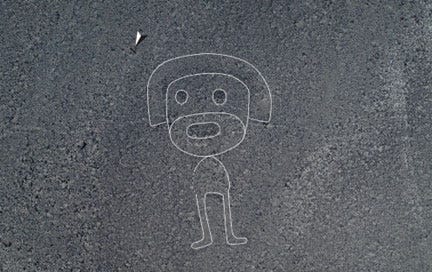🧐 Ancient Beat #39: Seafaring hominins, lost emperors, and new Nazca lines
Hi folks — I’m back! And my wife and I just welcomed our daughter into the world! 🎉🎉🎉 After spending a wonderful couple of weeks as a new family, I’m ready to get back to it with issue #39 of Ancient Beat. Since I’m just getting into the swing of things, we’ll start by focusing on the five biggest stories of the last few weeks. Next week, it’ll be back to full-length issues.
A couple of quick things to mention:
If you’d like to go premium for all the latest stories and content, I’m offering a holiday deal of 20% off until January 1! 😃
If you’d like to give someone the gift of ancient news this holiday season, you can purchase a subscription for a friend here.
Without further ado, here’s the latest ancient news. 👇
🗞 Ancient News: Top 5
Scientists Found 168 More Ancient Figures Etched Into the Peruvian Desert — Researchers have discovered 168 new geoglyphs in the Nazca Desert of Peru. The 2,000-year-old glyphs include depictions of humans, birds, orcas, cats, snakes, and more. The reason that they had been missed previously was probably their size — many are only 10 to 20 feet across. Luckily, drones were able to find them with high-res cameras.
Could Homo Naledi Control Fire? — Researchers have discovered remnants of hearths, including charred wood, burned animal bones, and soot, in the Rising Star cave complex of South Africa. What makes this particularly interesting is that the only human remains found to date in the caves are those of Homo naledi, a species that did not have control over fire… or so we thought. The naledi fossils date to 335,000-236,000 years ago, which is well within the timeline of fire usage, but they had small brains and were not thought to be capable. Of course, these findings are not conclusive. Indeed, the idea is quite controversial, with critics suggesting that the fires were built by visitors to the cave system, and that the bones were washed in by rain.
Oldest Charred Food Remains Reveal Earliest Evidence of Plant Cooking by Neanderthals — Analysis of some of the oldest charred food remains showed Neanderthals prepared food similar to Homo sapiens. The food pieces included seeds, wild pulses, wild mustard, wild nuts, and wild grasses, and could have been from porridge or patties. Some of the food fragments that were analyzed date back as far as 70,000 years. More recent fragments from up to 13,000 years ago may have made up a sort of proto-bread. From their analysis, the researchers were able to identify the ways in which Neanderthals and sapiens made their food edible, as well as the ways that they made it tastier — soaking, leaching, pounding, grinding, and even seasoning. According to Ceren Kabuku, “Our work conclusively demonstrates the deep antiquity of plant foods involving more than one ingredient and processed with multiple preparation steps… There were very ancient and sophisticated culinary traditions resting on these plant flavors.”
Roman Coin Reveals Long-Lost Roman Emperor — New analysis of unusual Roman coins which were thought to be forgeries has shown that they are authentic. The coins depict an unknown Roman emperor named “Sponsian”. He may have been an army officer who was forced to assume command in the Roman province of Dacia when it was cut off from the rest of the empire around 260 CE. It is assumed that he produced coins locally to cement his power, as he could not get official issues from Rome. According to Paul Pearson, “Scientific analysis of these ultra-rare coins rescues the emperor Sponsian from obscurity. Our evidence suggests he ruled Roman Dacia, an isolated gold mining outpost, at a time when the empire was beset by civil wars and the borderlands were overrun by plundering invaders.”
Hominins Were Sailing the Mediterranean Half a Million Years Ago, Study Finds — I think “sailing” is a bit of a misnomer in the article’s title, but a new study suggests that primitive hominins made short sea journeys in the Mediterranean Sea over half a million years ago. This is thanks to growing evidence of Mediterranean islands being populated for a very, very long time. They even found evidence that islands were populated multiple times by different hominins, so it was not a single event. The study showed that it would not have been possible for ancient humans to have simply walked to the Aegean Islands during a time of lower sea levels — there were times when the islands would have been one big island, but there still would have been at least 5 kilometers of sea between it and the mainland. According to Maria Gkioni, “The human species likes to explore new places, and we know they had visibility, they could see that perhaps there was a better place to find the resources they needed: food, water and stone.” Of course, we have no evidence of boats going back that far, and it’s possible that they simply swam or drifted on a log. Even still, Gkioni went on to say, “All this means that these hominins already had advanced cognitive capabilities… To cross over and colonize an island you need to have collaboration, a common language, and complex communication.”
That’ll do it for this week. As always, let me know your thoughts! Next week, we’ll get back to full-length issues. 😀
Until next time, thanks for joining me.
-James
(newish twitter: @jamesofthedrum)
P.S. If you like what you’re seeing, please consider forwarding it to a friend. It would mean a lot! 🙏




